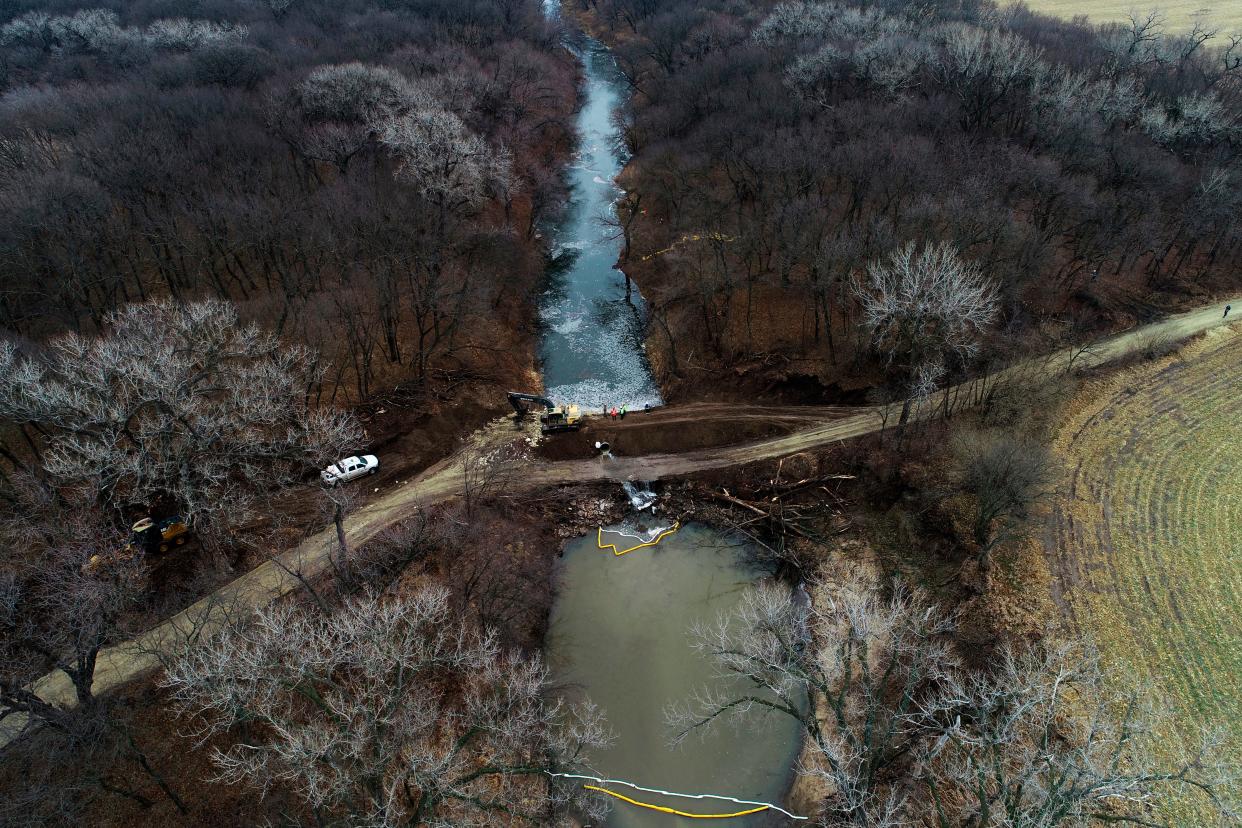Even as Keystone pipeline reopens, drone ban remains in effect over Kansas oil spill site

A ban on media and other entities from flying drones near a major oil spill in north-central Kansas remains in effect, even as the operator of the Keystone pipeline reopened the affected segment last week.
That effectively prevents the public from seeing the full impact of the oil spill.
The cause of the failure that led to the spill in early December, causing 14,000 barrels of crude oil to flow into Mill Creek outside Washington, remains unknown.
TC Energy, the pipeline's operator, announced last week that they had received approval from federal regulators to restart the pipeline segment that flows to Cushing, Oklahoma, through north-central Kansas.
Initially, the Pipeline and Hazardous Materials Safety Administration of the U.S. Transportation Department ordered operations on the 96-mile segment be halted until actions had been taken to address public health and environmental concerns.
Cleanup at the spill site is ongoing, with TC Energy saying Tuesday they would temporarily divert Mill Creek "from a location upstream of the pipeline spill to downstream of the containment dams."
“The diversion will assist in the cleanup and reclamation of the creek,” the company said in a statement Tuesday.
More:Company restarts Keystone portion affected by Kansas oil spill. The cause remains unknown.
'It's their interest to keep this out of sight and out of mind'
It is unclear how long the drone no-fly zone will be in place. In the days immediately following the spill, drone footage was the lone way media could photograph and document events.
Federal Aviation Administration records show the no-fly zone was renewed on Jan. 1 and that its latest iteration will expire on Saturday. It covers a 2-nautical-mile radius around the spill site. A nautical mile is slightly longer than a mile.
When asked for comment, TC Energy defended the need for the no-fly zone and said the company is "committed to being transparent and to providing access to media when it is safe to do so," though it did not respond when asked when reporters might obtain access to the spill site.
"Clearing the airspace remains critical for the safety and security of the pilots conducting ongoing monitoring as well as the working crew on the ground," the company said. "Crews are working around the clock on the incident and need to be distraction-free."
Zach Pistora, a lobbyist for the Kansas chapter of the Sierra Club, said he "wants to give (the company) the benefit of the doubt" on the no-fly zone.
Still, he said there were major issues with how little information TC Energy was disclosing to the public, arguing the public and news media "has been at the mercy of (the U.S. Freedom of Information Act) and gratuitous postings by the company."
"It's their interest to keep this out of sight and out of mind," Pistora said.
The company last week declined to provide a copy of the plan filed with PHMSA, with TC Energy and the agency requesting The Topeka Capital-Journal file a FOIA request for the information, which it has done.
More:As pipeline operator searches for cause of Kansas oil spill, residents await cleanup
Oil spill the largest in Keystone pipeline history
The spill is the largest in the history of the Keystone pipeline system, the largest onshore oil spill in nine years and likely the largest of its kind in Kansas history.
More than 500 workers have been laboring at the spill site in recent weeks. The creek runs through much of north-central Kansas and feeds the Blue River that flows into Tuttle Creek Lake.
The company has said it is spending $7,500 to purchase new radio equipment for Washington County emergency management officials and it has also started a giving program for the Washington County Hospital.
The pipeline stretches more than 2,700 miles across North America, carrying oil drawn from the tar sands of Alberta, Canada, to Texas to be refined and then distributed. A separate portion of the pipeline moves oil to a refinery in Illinois.
The type of crude oil carried by the pipeline is particularly difficult to clean, though TC Energy has maintained since the spill that drinking water wasn't affected and that the spill was contained by a dam four miles from the spill site.
The Kansas Department of Health and Environment, however, has said some chemicals were found downstream of the dam, a spokesperson told the Kansas News Service, and that the levels were within safe levels of consumption for humans but not animals.
Officials have recovered at least five deceased mammals and over 100 dead fish, all of which have been turned over to the Kansas Department of Wildlife and Parks for assessment.
This article originally appeared on Topeka Capital-Journal: As Keystone pipeline reopens after Kansas spill, drone ban in effect

